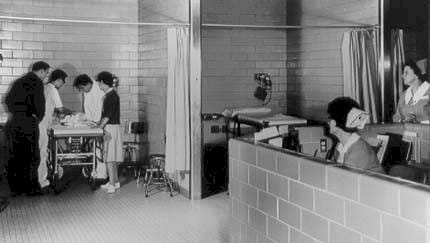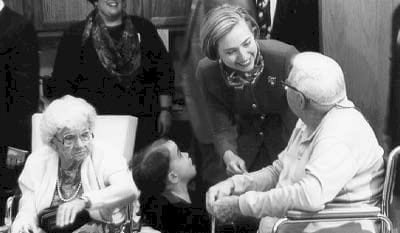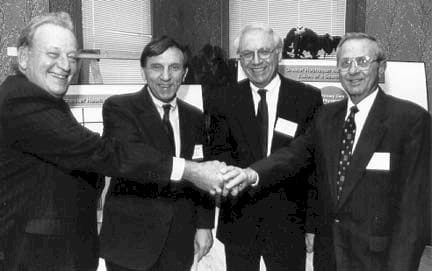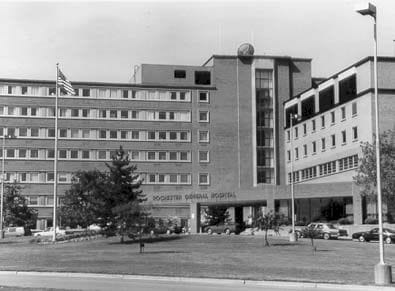General Content
When the Blizzard of '66 hit Rochester, critical staff members including the chief of Emergency were transported to the Hospital on snowmobiles.
Westside Division closed April 2, 1966, ending 102 years of service on West Main Street. Personnel and services of the two divisions were consolidated on Portland Avenue.
In 1967 the Research and Education Building opened. During the 1970s, the research program expanded dramatically in the areas of cardiology, clinical pharmacology, endocrinology, gastroenterology, hematology, immunology and infectious diseases, renal diseases and neurology. Research activities were closely integrated with the U of R's Medical School.
In planning Northside Division's Emergency Department in the 1950's, the directors and physicians had mistakenly assumed the patient load would be smaller than it was at the Main Street location. The Department became busier each year and quickly outgrew its facilities.

As part of the construction in the mid-60s, a larger E.D. was built, but that too was quickly outgrown. In response to consistent overcrowding, a modern, spacious facility was built in 1977 handling over 60,000 emergency visits each year.
With the help of an $800,000 gift from the Twigs, the Twig Birthing Center was opened in 1987. Initially, it included six state-of-the-art-birthing suites. By, 1997, the Center had grown to 16 birthing suites and a level II neonatal ICU.
In 1990 Rochester General became the first upstate New York hospital to offer atherectomy, a minimally invasive procedure that removes plaque and cholesterol from inside the heart's arteries.

Beginning in 1990 Independent Living For Seniors (ILS), a nationally recognized program for the community's elderly, opened. The ILS featured three adult day centers that provided services designed to keep seniors healthy and independent and to help them avoid unnecessary hospitalization. Physicians, therapists, social workers, nurses and dietitians work as a team to meet the needs of each participant. First Lady, Hillary Rodham Clinton, paid a visit to ILS in 1994. A fourth ILS site opened in 1997.
The Liebert Pavilion was dedicated early in 1997. In his early career, Arthur E. ("Fritz") Liebert oversaw the Hospital's original Westside Division and was active in consolidating the Northside site. In 1972 he was named the Hospital's top administrator. He helped expand the institution from a single-wing facility to a 526-bed health care complex with two medical office buildings, a research building, and a ramp garage. Liebert's most ambitious expansion effort was in 1987 when the Hospital added two new floors, relocated 208 patient rooms and added new cardiac medical intensive care units to its E-wing. On April 2, 1997 the E-wing was officially named the Arthur E. Liebert Pavilion in his honor.

In 1984 Rochester Health Care, Inc. was formed as a parent corporation for Rochester General Hospital, Rochester Mental Health Center, Rochester General Hospital Association and the Rochester General Hospital Foundation. Two years later the parent corporations of Rochester General Hospital (Rochester HealthCare, Inc.) and The Genesee Hospital (TGH Health System, Inc.) affiliated to form the Greater Rochester Health System (GRHS). GRHS included Rochester General, Genesee, Newark-Wayne Community Hospital and the Continuing Care Network, which oversees long-term care corporations including Independent Living for Seniors, Hill Haven nursing home and the Community Home Health Agency. As an integrated, patient-centered delivery system, GRHS provided a broad spectrum of care and services making health care less fragmented and more accessible.

On May 16, 1997, The Greater Rochester Health System, became ViaHealth comprised of Rochester General and its sister institutions, The Genesee Hospital, Newark-Wayne Community Hospital, the Behavioral Health Network and a Continuing Care Network of long-term care providers.
For further information consult To Serve the Community: A Celebration of Rochester General Hospital, 1847-1997, the Hospital's Sesquicentennial history.
CREDITS
Text by Philip G. Maples, Teresa K. Lehr and Christine Roth.
Photography: Vince Sullivan and Jeff Blackman and photos from the collections of The Baker-Cederberg Museum and Archives of the viaHealth Rochester General Hospital.
Design and graphics: Susan Maples